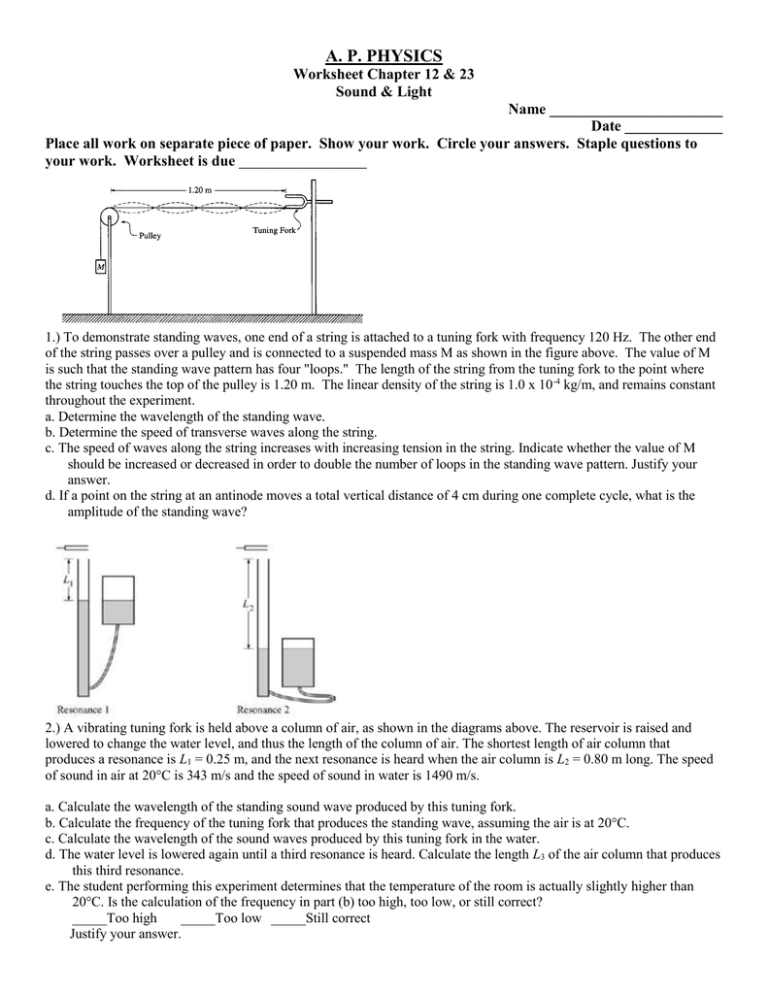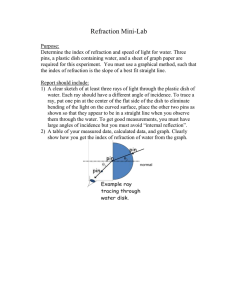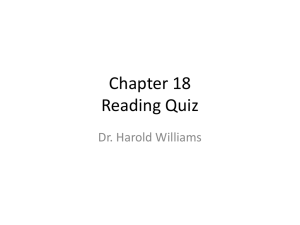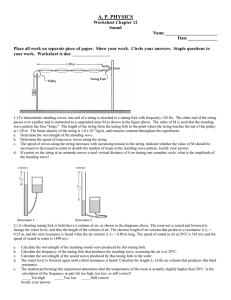ap physics
advertisement

A. P. PHYSICS Worksheet Chapter 12 & 23 Sound & Light Name _______________________ Date _____________ Place all work on separate piece of paper. Show your work. Circle your answers. Staple questions to your work. Worksheet is due _________________ 1.) To demonstrate standing waves, one end of a string is attached to a tuning fork with frequency 120 Hz. The other end of the string passes over a pulley and is connected to a suspended mass M as shown in the figure above. The value of M is such that the standing wave pattern has four "loops." The length of the string from the tuning fork to the point where the string touches the top of the pulley is 1.20 m. The linear density of the string is 1.0 x 10-4 kg/m, and remains constant throughout the experiment. a. Determine the wavelength of the standing wave. b. Determine the speed of transverse waves along the string. c. The speed of waves along the string increases with increasing tension in the string. Indicate whether the value of M should be increased or decreased in order to double the number of loops in the standing wave pattern. Justify your answer. d. If a point on the string at an antinode moves a total vertical distance of 4 cm during one complete cycle, what is the amplitude of the standing wave? 2.) A vibrating tuning fork is held above a column of air, as shown in the diagrams above. The reservoir is raised and lowered to change the water level, and thus the length of the column of air. The shortest length of air column that produces a resonance is L1 = 0.25 m, and the next resonance is heard when the air column is L2 = 0.80 m long. The speed of sound in air at 20°C is 343 m/s and the speed of sound in water is 1490 m/s. a. Calculate the wavelength of the standing sound wave produced by this tuning fork. b. Calculate the frequency of the tuning fork that produces the standing wave, assuming the air is at 20°C. c. Calculate the wavelength of the sound waves produced by this tuning fork in the water. d. The water level is lowered again until a third resonance is heard. Calculate the length L3 of the air column that produces this third resonance. e. The student performing this experiment determines that the temperature of the room is actually slightly higher than 20°C. Is the calculation of the frequency in part (b) too high, too low, or still correct? _____Too high _____Too low _____Still correct Justify your answer. 3.) A point source S of monochromatic light is located on the bottom of a swimming pool filled with water to a depth of 1.0 meter, as shown above. The index of refraction of water is 1.33 for this light. Point P is located on the surface of the water directly above the light source. A person floats motionless on a raft so that the surface of the water is undisturbed. a. Determine the velocity of the source's light in water. b. On the diagram above, draw the approximate path of a ray of light from the source S to the eye of the person. It is not necessary to calculate any angles. c. Determine the critical angle for the air-water interface. Suppose that a converging lens with focal length 30 centimeters in water is placed 20 centimeters above the light source, as shown in the diagram above. An image of the light source is formed by the lens. d. Calculate the position of the image with respect to the bottom of the pool. e. If, instead, the pool were filled with a material with a different index of refraction, describe the effect, if any, on the image and its position in each of the following cases. i. The index of refraction of the material is equal to that of the lens. ii. The index of refraction of the material is greater than that of water but less than that of the lens. 4.) A ray of red light in air (λ=650 nm) is incident on a semicircular block of clear plastic (n = 1.51 for this light), as shown above. The ray strikes the block at its center of curvature at an angle of incidence of 27°. a. Part of the incident ray is reflected and part is refracted at the first interface. i. Determine the angle of reflection at the first interface. Draw and label the reflected ray on the diagram above. ii. Determine the angle of refraction at the first interface. Draw and label the refracted ray on the diagram above. iii. Determine the speed of the light in the plastic block. iv. Determine the wavelength of the light in the plastic block. b. The source of red light is replaced with one that produces blue light ( λ=450 nm ), for which the plastic has a greater index of refraction than for the red light. Qualitatively describe what happens to the reflected and refracted rays. c. The semicircular block is removed and the blue light is directed perpendicularly through a double slit and onto a screen. The distance between the slits is 0.15 mm. The slits are 1.4 m from the screen. i. On the diagram of the screen below, sketch the pattern of light that you should expect to see. ii. Calculate the distance between two adjacent bright fringes. 5.) A student performs an experiment to determine the index of refraction n of a rectangular glass slab in air. She is asked to use a laser beam to measure angles of incidence θi in air and corresponding angles of refraction θr in glass. The measurements of the angles for five trials are given in the table below. a. Complete the last two columns in the table by calculating the quantities that need to be graphed to provide a linear relationship from which the index of refraction can be determined. Label the top of each column. b. On the grid below, plot the quantities calculated in (a) and draw an appropriate graph from which the index of refraction can be determined. Label the axes. c. Using the graph, calculate the index of refraction of the glass sla The student is also asked to determine the thickness of a film of oil (n = 1.43) on the surface of water (n = 1.33). Light from a variable wavelength source is incident vertically onto the oil film as shown above. The student measures a maximum in the intensity of the reflected light when the incident light has a wavelength of 600 nm. d. At which of the two interfaces does the light undergo a 180° phase change on reflection? _____ The air-oil interface only _____Both interfaces _____The oil-water interface only _____Neither interface e. Calculate the minimum possible thickness of the oil film. 6.) The figure above shows a converging mirror, its focal point F, its center of curvature C, and an object represented by the solid arrow. a. On the figure above, draw a ray diagram showing at least two incident rays and the image formed by them. b. Is the image real or virtual? ____ Real ____ Virtual Justify your answer. c. The focal length of this mirror is 6.0 cm, and the object is located 8.0 cm away from the mirror. Calculate the position of the image formed by the mirror. (Do NOT simply measure your ray diagram.) d. Suppose that the converging mirror is replaced by a diverging mirror with the same radius of curvature that is the same distance from the object, as shown below. For this mirror, how does the size of the image compare with that of the object? ____ Larger than the object ____ Smaller than the object ____ The same size as the object Justify your answer.







